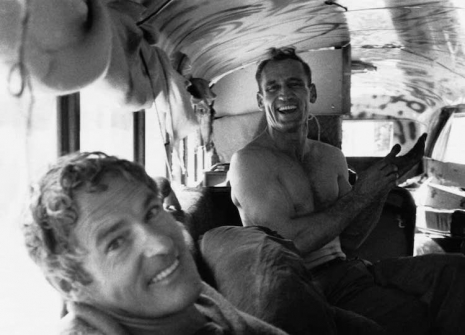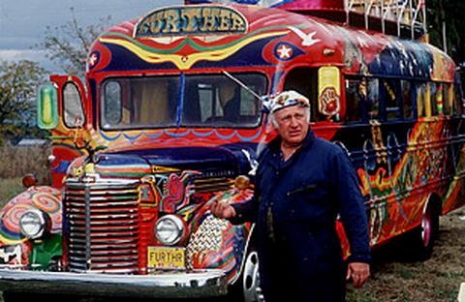
In 1964 Ken Kesey published Sometimes a Great Notion, the follow-up to his smash novel One Flew Over the Cuckoo’s Nest; in order to meet certain obligations in New York City, Kesey decided to use a psychedelically-painted school bus as his means of getting there from the West Coast. The bus, of course, was called Further or, if you were in the mood, Furthur.
It was all a great romantic quest to make known the benefits of LSD, at a time when the drug was not illegal in the United States (that wouldn’t last long), and only a couple of years after Cary Grant, of all people, had been touting its benefits in the pages of the New York Herald Tribune and elsewhere.

Timothy Leary and Neal Cassady on the storied bus Further
Tom Wolfe chronicled the memorable trip in The Electric Kool-Aid Acid Test, but if you’re looking for a more audio-visual account of the journey, you could do a lot worse than Tripping, which appeared on Channel 4 in Great Britain on August 7, 1999.
Kesey called the whole idea of their magic bus “an American glyph,” which is interesting. As Kesey says, Further was a powerful symbol of a vehicle that will pick you up and safely transport you to a place where your mind will be expanded.
Directed by Vikram Jayanti, Tripping uses some of the copious 16-mm footage taken during the trip by the participants—even more of this footage would appear in the 2011 documentary Magic Trip. The fact that Tripping is a British production would explain the prevalence of British interview subjects, including Malcolm McLaren, Jarvis Cocker, and Norman Cook, a.k.a. Fatboy Slim. Cook and Cocker were born in Bromley and Sheffield, respectively, one year before the events being described, so it’s unclear what insights either can offer as to, e.g. Kesey’s organizational abilities, but whatever.

The program also features perfectly authoritative sources, such as Marianne Faithfull, Paul Krassner, and Hunter S. Thompson. The British audience apparently requires subtitles to decipher HST’s remarks but I can make it all out…....
The YouTube upload lists this as a 1998 release but one of the first things in the movie is a title indicating that the footage was shot in Eugene, Oregon, in 1999, so that’s obviously false.